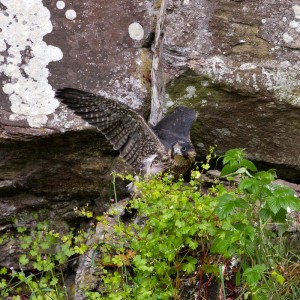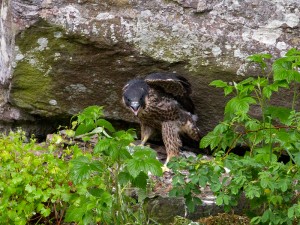They are still here!
Our juvenile falcons are still on the ledge, but look to be very close to taking that first jump. The flight feathers look to be almost the length needed. So it will just be a case of them building up their confidence. Both birds are doing a lot of wing flapping, they will not fledge until they start to get some lift from this activity. An eyas won’t go from the nest until it is sure that it can fly!
It is great seeing the young falcons, watching the adults and picking up their behaviour. They see the falcon leave the eyrie after standing up on the fore lying rock, so one of them has taken to standing on this, as she, does flapping it’s wings. They have also learnt to tear up meat. One eyas, after watching the adult female feed them a carcass, picked up large clump of grass and ripped it apart in the same manner! (it did not continue on to eat it!).

The chicks were well fed on a pigeon this afternoon by the falcon, so much so they were flat out asleep for the following few hours. The tiercel brought a starling to the ledge during this time. He seems to be scared of these 2 large juvenile falcons walking towards him with their mouths wide open, so he leaves instantly. Both chicks seemed uninterested until one of them picked up the carcass and walked round with it. Eventually it went on it store it in the grassy area below the main ledge. Storing food is another aspect of the adults behaviour they have learnt.
Being a keen student, is an important characteristic for a chick to have, they need to learn to fly and hunt from their parents. Those that do not become strong fliers and good hunters quickly, will not survive their first winter. It is just as important that a chick is taught well and is willing to learn, as as it is to be strong genetically and well fed on the nest.
I can currently tell the difference between our young falcons, as one has a pale forehead and the others is dark. So keep an eye out for this on the webcam. This weekend should be very exciting as we wait for the first chick to fly, so come join us if you can!

The adult female seems to have been a bit lethargic recently, only hunting every couple of days. She has spent much of her time sitting around, sometimes not even moving to take food off the male or to interfere with the chicks feeding. Females do lose condition during the breeding season, especially older ones. Our falcon was insistent on staying with the chicks for much of the first month of their lives. She also did a vast majority of the incubation this year, It is possible she is building up her energy again after a tough season.
She does seem to be managing her energy well only going out hunting when really necessary. This is obviously putting quite a strain on the tiercel, who has been hunting regularly all season, but he seems to be coping well. The falcons lethargy doesn’t seem to stop her having the occasional sudden burst of energy. This afternoon the male was sheltering on ‘the rain’ perch on the cliff, before the falcon decided she wanted to sit their and chased him off! If this wasn’t enough she then called at him to go out hunting! He went elsewhere to wait until the rain eased off, before proceeding to catch a starling. Our tiercel rarely gets his feathers wet!
Tom Wells – Peregrine Protection Officer
Help protect Scotland’s wildlife
Our work to save Scotland’s wildlife is made possible thanks to the generosity of our members and supporters.
Join today from just £3 a month to help protect the species you love.
Preface
Our juvenile falcons are still on the ledge, but look to be very close to taking that first jump. The flight feathers look to be almost the length needed. So …
